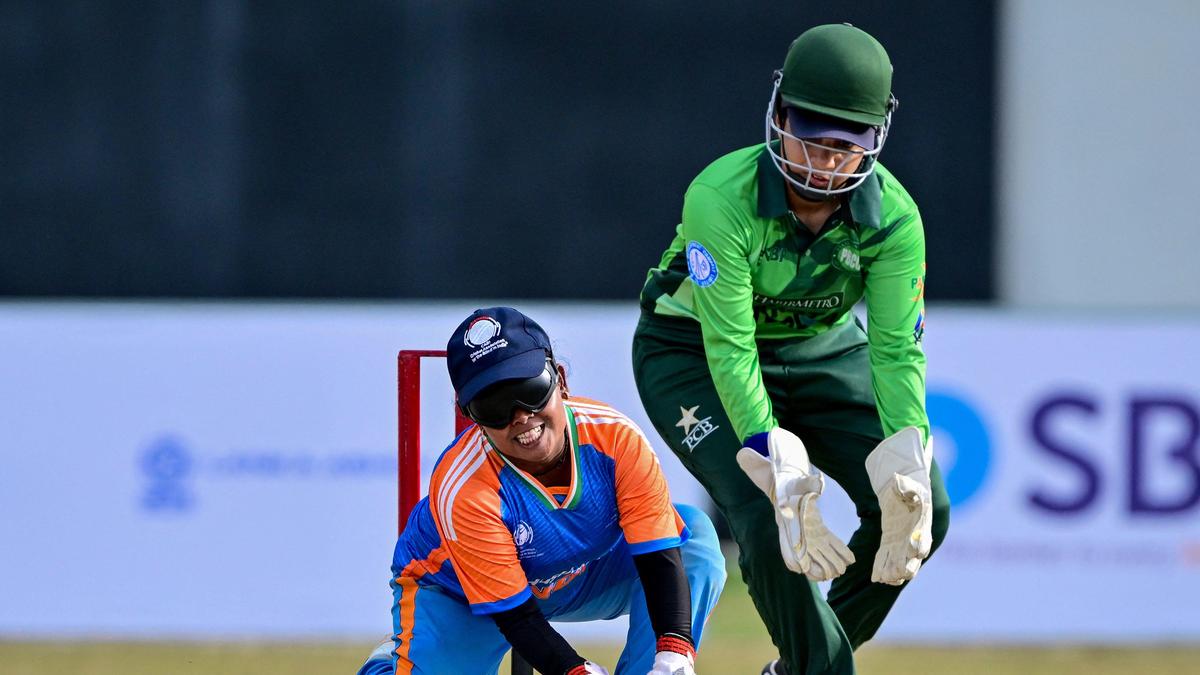Barely a month after India lifted the Women’s ODI World Cup, another women’s team has been training intensely for a series that culminates in Colombo on Sunday (November 23, 2025) — the first ‘Women’s T20 World Cup for the Blind’.
The series, co-hosted by India and Sri Lanka, began earlier this month with six teams — India, Pakistan, Nepal, Sri Lanka, Australia, and the U.S. — playing qualifying matches in New Delhi and Bengaluru. India will play Nepal in the final match at the P. Saravanamuttu Stadium, or ‘Colombo Oval’, the only Asian cricket ground to host Sir Don Bradman (in 1948).
“There is no tension,” says Karnataka-born Deepika T.C., captain of the Indian team. “That is because we are not just a team of batters, bowlers, and fielders, everyone is an all-rounder.”
Unlike cricket for sighted persons, blind cricket is played with a white-coloured plastic with ball bearings, for it to be heard by the players. Once the bowler knows the batter on strike is ready, she must shout out “play”, so the batter can anticipate an approaching ball — delivered underarm — and time her batting action accordingly. Each team has at least four persons with complete visual impairment and the rest with different lesser degrees of visual impairment, where players can see up to two, or six metres in distance.
“A lot goes into training blind cricketers so they can assess space, both for their safety and to plan their movement around the ground. And then they must adapt to the demands of the game, in terms of physical fitness and mental health,” says Shika Shetty, who manages the Indian team.
Phula Saren is thrilled to play for India. “I am not only representing my country, but also my village in Balasore district in Orissa. It makes me very proud,” says the 18-year-old, ardent Jemimah Rodrigues fan.
The players in India’s blind women’s cricket team are aged between 16 and 28 years, and come from poor homes in rural India, according to Ms. Shetty. The Cricket Association for the Blind in India (CABI) selects and trains players from across the country’s villages. “Getting into the game is not only a big shift for girls from modest homes, but also makes a huge difference to their families who see them shine in this field,” said Mahantesh G. Kivadasannavar, CABI Chairperson and the brain behind the tournament.
Cricket being a sequential game with a lot of strategy allows players with visual impairment to navigate the rules and physical space, he notes, underscoring the need for more infrastructure and financial support to create more opportunities. “From the idea stage to actual execution, we managed to pull it off in less than two months, only because of the enormous support we received from Sri Lankan authorities, Indian officials, and our many sponsors and supporters,” Mr. Kivadasannavar says.
Anikha Devi from Jammu and Kashmir was introduced to the game by her uncle, also a person with visual impairment. “Just wearing this blue jersey and practising with my teammates, it’s a great feeling,” says the 20-year-old, who is studying programming.
For Sri Lanka, the tournament brought an opportunity to quickly put together its own blind women’s cricket team. “We brought in students from the university and others who were very interested in this game. We couldn’t have missed such a great opportunity,” says Sudesh Tharanga, President of the Sri Lanka Cricket Association for the Visually Handicapped.
Many among the players are pursuing their university education in parallel to their cricket coaching. Nimra Rafique, who plays for the Pakistan team, is studying for a bachelor’s degree in education. Asked what she would pick as a full-time career, “Both. Why, it is possible!” she asserts with a beaming smile. One thing that players from all sides agree on is how beautiful Colombo is, “although quite warm”. “We went to the seaside, and the breeze was just lovely,” Ms. Rafique says.

